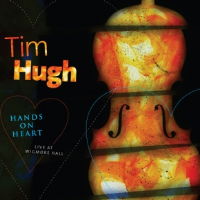
Poetic Lyricism
Tim Hugh and Olga Sitkovetsky at London's Wigmore Hall -
enjoyed by
HOWARD SMITH'... breathtaking musicianship captured my attention ...'
|

|
Tim Hugh needs no introduction to British concertgoers and his reputation among informed international music lovers is second to none. Moreover he's a tireless advocate of contemporary music and maintains his position as principal cellist with the LSO.
Tim studied at Yale with Aldo Parisot and afterwards with William Pleeth and Jacqueline du Pré whilst gaining his MA in Medicine and Anthropology at St Johns College, Cambridge. Today, at the height of his powers, he plays a cello by Petrus Roman of Venice (1708).
Listen -- Piazzolla: Le Grand Tango
(track 6, 3:26-4:37) © 2008 Naim Audio Ltd
'Hands on Heart' is a permanent reminder of the Wigmore Hall concert (26 November 2007), commemorating Steve Hugh (1959-2006).
In Tim's own words, 'the concert is both a tribute and celebration of my brother Steve's life ... despite his youth and energy, he suffered an unexpected and fatal heart attack. Both Steve's family and I are delighted to donate the proceeds from this tribute concert to the British Heart Foundation.'
A viola player, recreational walker, GP, and Manager of Shropdoc (Shropshire Doctors' Cooperative), Steve Hugh (1959-2006) was husband to Deb, father of Sam and Emma, and brother to Tim, Nick and sister Rachel.
The memorial concert programme, with peripatetic, consistently empathetic accompanist Olga Sitkovetsky, avoids classical items; its earliest composer -- Paganini (1782-1840) and most recent, Ástor Piazzolla (1921-1992).
Central to the recital is Kodály's vital, demanding Sonata for Solo Cello, Opus 8, while elsewhere Hugh wisely side-steps Rachmaninoff's oft-repeated song, Vocalise, in favour of Ne Poy Krasavitsa, Op 4/4a, a gorgeous Pushkin setting (one of six) transcribed for cello.
Listen -- Paganini: Moses in Egypt
(track 8, 0:01-0:58) © 2008 Naim Audio Ltd
Time after time points of distinction and breathtaking musicianship captured my attention; a case in point ... the poetic lyricism Hugh invests in the three-minute introduction to Paganini's Moses in Egypt variations; a welcome contrast to the pugnacious gloss and vibrancy powerhouse virtuoso violinists lavish on this preparatory theme.
Kodály's Sonata, Opus 8 is rife with technical hurdles, all of which Hugh surmounts with commanding ease. Having said that his performance is essentially both poetic and ruminative, missing out on much of Kodály's ardor and ferocity. For those we must turn to the incomparable Janos Starker. His 2nd (1970) Japanese studio recording (length: 30'46") on Delos is a top recommendation.
Starker's exhilarating Paris recording from the 1950s (length: 27'36") is also available on a two CD set 'János Starker's Legendary 1950s Period LPs, Vol 1' (Essential Media Group -- a South Florida based record label).
Hugh rates high among more recent versions though he (and Naxos' Maria Kliegel) are eclipsed by Andorran cellist, fifty-seven-year-old Lluis Claret, playing a Nicolas Lupot cello (Paris, 1820).
In 1995 the Pyrenees virtuoso recorded Kodály's Opus 8 and Sonata, Opus 4 with pianist Rose-Marie Cabestany (harmonia mundi HMA1901325).
Listen -- Bartók: Friss (Rhapsody No 1)
(track 2, 4:22-5:33) © 2008 Naim Audio Ltd
Wigmore Hall's programme begins with the first of Bartók's two 2-part folk rhapsodies (1928/29) transcribed from the violin and orchestra / or piano original -- ie Rhapsody No 1, Sz87. (Part 1 'lassu': Moderato; Part 2 'friss': Allegretto moderato.)
Following the measured, folksy (Transylvania/Erdély) theme, marked lassu, Bartók's moderato dance flanks a central melody to which Hugh brings exquisite sensitivity. Part Two has minimal such respite and the opening sixty seconds, closely resembling a theme from Copland's Appalachian Spring, recurs in scraps throughout a complex labyrinth of dazzling folk music. While Hugh falls short of top gear Czardas-like vehemence, his mastery of the idiom is never in doubt.
Bartók scholars and enthusiasts should not be without violinist Josef Szigeti's legendary 1940 recording with Bartók himself at the piano. This live recital, under the auspices of the Elizabeth Sprague Coolidge Festival and available on the Vanguard Classics label (OVC 8008), was recorded at the Library of Congress, Coolidge Auditorium, Washington DC on 13 April 1940. It was miraculously preserved on acetate discs.
My former work colleague, David Denton (The Strad) comments 'the (Szigeti/Bartók) sound is small but ... clear, and there are scratches and surface noise from the acetates ... but sonic considerations count for nothing in the face of the artistic and historical significance of this recital, possibly one of the most important recorded documents of 20th century classical music'.
Note that the Bartók Rhapsody is designated according to the catalogue numbering of András Szöllosy (1921-2007).
Other items are Piazzolla's Le Grand Tango (1982), dedicated to Rostropovitch and premièred by 'Slava' in New Orleans (1990).
For good measure, Hugh also includes Glazunov's Chant du Menestrel (1900), a wistful Russian ballad; while punters eager for a thrill find, Rimsky-K's jet-assisted Flight of the Bumble Bee accorded a nonchalant, pesky ZZZzzzzssssss.
Listen -- Fauré: Après un rêve
(track 11, 2:17-3:13) © 2008 Naim Audio Ltd
A prolonged audience hush after the final bars of Hugh's concluding item -- Gabriel Fauré's Après un rêve, Op 7 No 1, the languid setting of an anonymous poem, is testament to refined expression, technical finesse, and superlative tonal control distinguishing this comprehensive programme.
A more fitting, familial way to be commemorated is difficult to imagine.
Copyright © 2 November 2008
Howard Smith, Masterton, New Zealand
 BUY CLASSICAL CDS ONLINE
TIM HUGH - HANDS ON HEART - LIVE AT WIGMORE HALL
BUY CLASSICAL CDS ONLINE
TIM HUGH - HANDS ON HEART - LIVE AT WIGMORE HALL
| 
